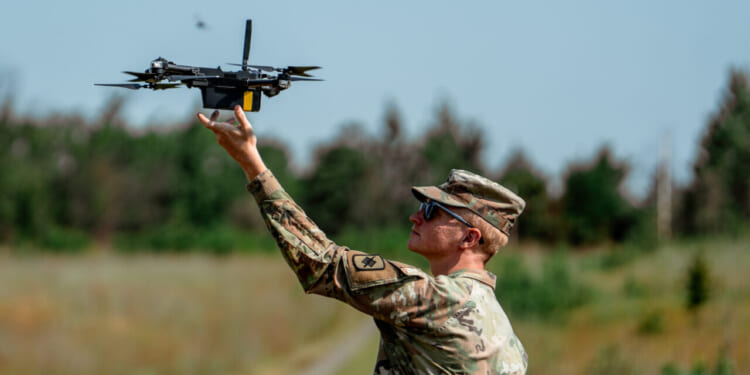Given the reality of the war in Ukraine, the US military is right to pay close attention to developments in drone technology.
Drones are here to stay, and the US Army wants to produce 120,000 unmanned aerial systems per year by 2026.
At the same time, there is a proposed law in Congress that would require the government to produce 1 million small drones per year.
Drone Frenzy
The US Army Materiel Command is working on “SkyFoundry,” a pilot program designed to rapidly develop, test, and produce small unmanned aerial systems. According to Army officials, the goal is to produce as many as 10,000 drones per month initially, with goals for 20,000 drones per month later down the line. Army officials are currently searching for and identifying facilities that can support the program.
“I think 90 percent of the domestic drone market is owned by China, so we can’t go to that. So, let’s create our own domestic drone market,” Undersecretary of the Army Michael Obadal said during a fireside chat at the Association of the United States Army’s annual meeting and exposition on Tuesday.
At the same time, US lawmakers are promoting legislation that would revolutionize the domestic US drone market. In the summer, Representative Pat Harrigan, R-N.C., introduced the SkyFoundy Act of 2025.
“China and Russia are flooding the battlefield with millions of drones while America has sat on its hands. More than 80% of casualties in modern war now come from drones, yet we still have no capacity to build them at scale. That failure is reckless, and it leaves our troops exposed,” Harrigan said in a statement.
Senators Ted Cruz, R-Texas, John Cornyn, R-Texas, John Boozman, R-Ark, and Tom Cotton, R-Ark, introduced companion legislation in the Senate in July. The legislation prompts the Pentagon to establish government-owned facilities that design, develop, and produce unmanned aerial systems.
The legislation has not passed the House or the Senate yet.
“This bill creates the capacity to design, test, and build a million drones a year right here in America. It cuts China out of our supply chains, it arms our troops with what they need to dominate, and it makes clear we will never again let our enemies outproduce us in the weapons that decide wars,” Harrigan added.
The War of the Drones
Rapid advancements in unmanned aerial systems technology have revolutionized warfare. To be sure, drones are not new to warfare. Unmanned aerial systems have been in development by militaries and intelligence services around the world since the 1980s. It was the US military and intelligence community that truly pioneered drone technology in the 1990s. When the United States went to war in the Middle East following the terrorist attacks of 9/11 in 2001 and the invasion of Iraq in 2003, the US military started using drones to provide overhead intelligence, surveillance, and intelligence support to ground troops, as well as for kinetic strikes against high-value targets. For example, the CIA used drones to kill al-Qaeda leader Ayman al-Zawahiri in 2022. During these early years, drone technology was not as advanced as it is today, and drones used missiles to strike their targets rather than being the munitions themselves, like suicide drones.
The conflict in Ukraine has taken drone warfare to another level. This is the first conflict in history where both combatants possess robust unmanned aerial systems capabilities. In many ways, the war in Ukraine is the war of the drones. The US military is right to pay close attention to developments in drone technology and application, as a near-peer conflict with Russia or China would almost certainly involve heavy application of unmanned aerial systems.
About the Author: Stavros Atlamazoglou
Stavros Atlamazoglou is a seasoned defense journalist specializing in special operations and a Hellenic Army veteran (national service with the 575th Marine Battalion and Army HQ). He holds a BA from the Johns Hopkins University and an MA from the Johns Hopkins’ School of Advanced International Studies (SAIS). His work has been featured in Business Insider, Sandboxx, and SOFREP.
Image: DVIDS.

















